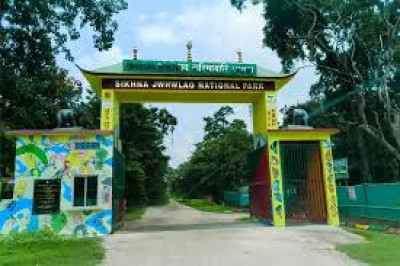In Depth
History & Significance of Sikhna Jwhwlao National Park
The park is named after Sikhna Jwhwlao, also known historically as Joulia Dewan, a revered Bodo warrior who fought against British colonial forces during the Duar War (1864–1866). His former capital, Sikhnajhar or Chiknajhar, is located in the present-day Ultapani Reserve, now within the boundaries of the national park. The location is considered sacred by the Bodo community and remains a site of traditional ceremonies such as Bathou Puja and Kherai Puja.
Sikhna Jwhwlao National Park originated from the previously notified Chirang–Ripu Elephant Reserve. Through extensive conservation efforts and biodiversity assessments, the government upgraded the area to full national park status to safeguard endangered fauna, check encroachments, and revive degraded forest patches.
Geographical Location of Sikhna Jwhwlao National Park
Situated in the foothills of the Eastern Himalayas, the park lies along the Indo–Bhutan border and forms part of the larger Manas Biosphere Reserve. Its terrain includes semi-evergreen forests, riverine belts, bamboo groves, grasslands, and hilly landscapes. The park’s strategic location makes it an essential wildlife passage connecting Assam with Bhutan’s protected forests.
Flora & Fauna (Biodiversity Hotspot) at Sikhna Jwhwlao National Park
Sikhna Jwhwlao National Park is recognized as a biodiversity hotspot, home to an extraordinary variety of wildlife species. It is especially famous for its butterflies, with more than 460 species recorded—making it one of the richest butterfly zones in Northeast India. The Ultapani region within the park is a popular butterfly-watching destination.
Major Wildlife Species Found Here
-
Golden Langur – the flagship species of BTR and one of the world’s rarest primates
-
Royal Bengal Tiger
-
One-Horned Rhinoceros
-
Asian Elephant
-
Gaur (Indian Bison)
-
Leopard & Clouded Leopard
-
Pygmy Hog & Hispid Hare
-
Hornbills, Eagles, Parakeets
-
Numerous amphibians, reptiles, and freshwater species
The combination of plains, hills, and riverine ecosystems makes the park an ideal habitat for both migratory and resident species.
Things to Do in Sikhna Jwhwlao National Park
Although still a developing destination, the park offers unique experiences:
1. Butterfly Watching at Ultapani
A paradise for nature lovers, Ultapani is globally recognized for its extraordinary butterfly diversity.
2. Wildlife Viewing & Birding
Spot rare mammals, primates, and migratory birds across multiple zones of the park.
3. Nature Trails & Photography
The diverse landscape provides excellent opportunities for landscape and wildlife photography.
4. Off-Road Biking & Eco-Tourism Activities
Some areas allow supervised adventure activities promoted by local communities and BTR tourism bodies.
5. Cultural Visits
Explore traditional Bodo villages and witness local rituals at sacred cultural sites.
Best Time to Visit Sikhna Jwhwlao National Park
HOW TO REACH Sikhna Jwhwlao National Park
By Air
The nearest major airport is Guwahati International Airport, around 230–250 km away. Visitors can hire a taxi or take a bus to reach Kokrajhar or Chirang.
By Train
The closest railway stations are:
-
Kokrajhar Railway Station
-
New Bongaigaon Junction
Both are well connected to major Indian cities.
By Road
Sikhna Jwhwlao National Park is easily accessible by road from:
Kokrajhar (approx. 35–40 km)
Chirang (approx. 30–40 km)
Bongaigaon (approx. 70 km)
Local taxis, shared vehicles, and buses are available from these towns.
Quick Info Table on Sikhna Jwhwlao National Park
| Particulars | Details |
|---|---|
| National Park Name | Sikhna Jwhwlao National Park |
| Location | Kokrajhar & Chirang districts, BTR, Assam |
| Area | 316.29 sq km approx. |
| Established | 2025 (Notified under Wildlife Protection Act, 1972) |
| Named After | Bodo warrior Sikhna Jwhwlao (Joulia Dewan) |
| Famous For | Golden Langur, 460+ butterfly species, elephants, tigers |
| Nearest Railway Station | Kokrajhar & New Bongaigaon |
| Nearest Airport | Guwahati International Airport |
| Best Time to Visit | November to March |
| Region Type | Eastern Himalayan foothills, semi-evergreen forests |
| Part of | Manas Biosphere Reserve |
FAQs on Sikhna Jwhwlao National Park
1. Where is Sikhna Jwhwlao National Park located?
It is located in the Kokrajhar and Chirang districts of the Bodoland Territorial Region (BTR) in Assam.
2. When was Sikhna Jwhwlao National Park declared?
The park was officially notified as a national park in early 2025.
3. Why is the park named Sikhna Jwhwlao?
It is named after the legendary Bodo leader and warrior Sikhna Jwhwlao, known for resisting British forces during the Duar War.
4. What is Sikhna Jwhwlao National Park famous for?
It is known for its rich biodiversity, especially 460+ butterfly species, Golden Langur, and Eastern Himalayan wildlife.
5. How big is Sikhna Jwhwlao National Park?
The park covers approximately 316 sq km.
6. Which national parks are connected to Sikhna Jwhwlao?
It lies between Manas National Park and Raimona National Park, forming a large contiguous wildlife landscape.
7. What is the best time to visit Sikhna Jwhwlao National Park?
November to March is the ideal visiting season.
8. How to reach Sikhna Jwhwlao National Park?
Travelers can reach via Kokrajhar or Chirang by road, with the nearest major airport in Guwahati and railway stations at Kokrajhar or New Bongaigaon.
9. What wildlife can be seen in the park?
Golden langur, elephants, one-horned rhinoceros, tigers, bison, clouded leopards, and hundreds of bird and butterfly species.
10. Is Sikhna Jwhwlao National Park part of the Manas Biosphere Reserve?
Yes, it forms a vital ecological corridor within the Manas Biosphere Reserve.
